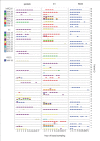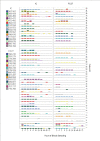Plasmodium falciparum population dynamics during the early phase of anti-malarial drug treatment in Tanzanian children with acute uncomplicated malaria
- PMID: 22185672
- PMCID: PMC3280947
- DOI: 10.1186/1475-2875-10-380
Plasmodium falciparum population dynamics during the early phase of anti-malarial drug treatment in Tanzanian children with acute uncomplicated malaria
Abstract
Background: This study aimed to explore Plasmodium falciparum population dynamics during the early phase of anti-malarial drug treatment with artemisinin-based combination therapy in children with clinical malaria in a high transmission area in Africa.
Methods: A total of 50 children aged 1-10 years with acute uncomplicated P. falciparum malaria in Bagamoyo District, Tanzania, were enrolled. Participants were hospitalized and received supervised standard treatment with artemether-lumefantrine according to body weight in six doses over 3 days. Blood samples were collected 11 times, i.e. at time of diagnosis (-2 h) and 0, 2, 4, 8, 16, 24, 36, 48, 60 and 72 h after initiation of treatment. Parasite population dynamics were assessed using nested polymerase chain reaction (PCR)-genotyping of merozoite surface protein (msp) 1 and 2.
Results: PCR-analyses from nine sequential blood samples collected after initiation of treatment identified 20 and 21 additional genotypes in 15/50 (30%) and 14/50 (28%) children with msp1 and msp2, respectively, non-detectable in the pre-treatment samples (-2 and 0 h combined). Some 15/20 (75%) and 14/21 (67%) of these genotypes were identified within 24 h, whereas 17/20 (85%) and 19/21 (90%) within 48 h for msp1 and msp2, respectively. The genotype profile was diverse, and varied considerably over time both within and between patients, molecular markers and their respective families.
Conclusion: PCR analyses from multiple blood samples collected during the early treatment phase revealed a complex picture of parasite sub-populations. This underlines the importance of interpreting PCR-outcomes with caution and suggests that the present use of PCR-adjustment from paired blood samples in anti-malarial drug trials may overestimate assessment of drug efficacy in high transmission areas in Africa.The study is registered at http://www.clinicaltrials.gov with identifier NCT00336375.
Figures






Similar articles
-
Therapeutic efficacy of artemether-lumefantrine in uncomplicated falciparum malaria in India.Malar J. 2009 May 19;8:107. doi: 10.1186/1475-2875-8-107. Malar J. 2009. PMID: 19454000 Free PMC article. Clinical Trial.
-
Therapeutic efficacy of artemether-lumefantrine for the treatment of uncomplicated Plasmodium falciparum malaria from three highly malarious states in India.Malar J. 2016 Oct 13;15(1):498. doi: 10.1186/s12936-016-1555-4. Malar J. 2016. PMID: 27737665 Free PMC article.
-
Assessing the therapeutic efficacy of artemether-lumefantrine for uncomplicated malaria in Lagos, Nigeria: a comprehensive study on treatment response and resistance markers.Malar J. 2024 Aug 29;23(1):261. doi: 10.1186/s12936-024-05088-6. Malar J. 2024. PMID: 39210367 Free PMC article.
-
Coartem: the journey to the clinic.Malar J. 2009 Oct 12;8 Suppl 1(Suppl 1):S3. doi: 10.1186/1475-2875-8-S1-S3. Malar J. 2009. PMID: 19818170 Free PMC article. Review.
-
PCR correction strategies for malaria drug trials: updates and clarifications.Lancet Infect Dis. 2020 Jan;20(1):e20-e25. doi: 10.1016/S1473-3099(19)30426-8. Epub 2019 Sep 17. Lancet Infect Dis. 2020. PMID: 31540841 Review.
Cited by
-
Persistence of Plasmodium falciparum parasitemia after artemisinin combination therapy: evidence from a randomized trial in Uganda.Sci Rep. 2016 May 20;6:26330. doi: 10.1038/srep26330. Sci Rep. 2016. PMID: 27197604 Free PMC article.
-
Genetic polymorphism of merozoite surface protein 2 and prevalence of K76T pfcrt mutation in Plasmodium falciparum field isolates from Congolese children with asymptomatic infections.Malar J. 2012 Apr 1;11:105. doi: 10.1186/1475-2875-11-105. Malar J. 2012. PMID: 22463364 Free PMC article.
-
The temporal dynamics of Plasmodium species infection after artemisinin-based combination therapy (ACT) among asymptomatic children in the Hohoe municipality, Ghana.Malar J. 2023 Sep 14;22(1):271. doi: 10.1186/s12936-023-04712-1. Malar J. 2023. PMID: 37710288 Free PMC article.
-
Prevalence of and Risk Factors Associated with Polymerase Chain Reaction-Determined Plasmodium falciparum Positivity on Day 3 after Initiation of Artemether-Lumefantrine Treatment for Uncomplicated Malaria in Bagamoyo District, Tanzania.Am J Trop Med Hyg. 2019 May;100(5):1179-1186. doi: 10.4269/ajtmh.18-0729. Am J Trop Med Hyg. 2019. PMID: 30860013 Free PMC article.
-
Limited Reliability of the Molecular Detection of Plasmodium spp. from Incubated Blood Culture Samples for Forensic Purposes.Microorganisms. 2022 Feb 10;10(2):406. doi: 10.3390/microorganisms10020406. Microorganisms. 2022. PMID: 35208861 Free PMC article.
References
-
- World Health Organization. Guidelines for the treatment of malaria. 2. Geneva: WHO; 2010. - PubMed
-
- Venture MfM, World Health Organization. Methods and techniques for clinical trials on antimalarial drug efficacy: genotyping to identify parasite populations. Informal consultation organized by the MMV and cosponsored by the WHO 29-31 May 2007 Amsterdam; 2008.
-
- World Health Organization. Assessment and monitoring of antimalarial drug efficacy for the treatment of uncomplicated falciparum malaria. Geneva; 2003.
Publication types
MeSH terms
Substances
Associated data
LinkOut - more resources
Full Text Sources
Medical
Research Materials

